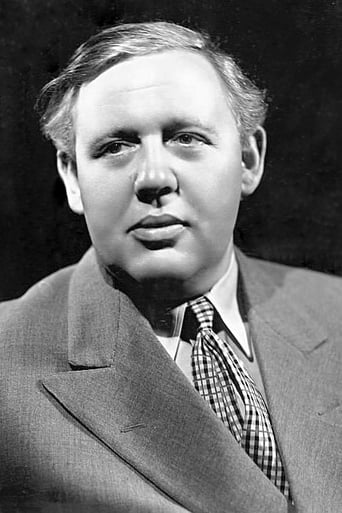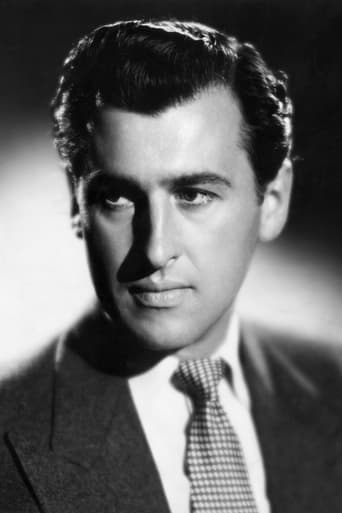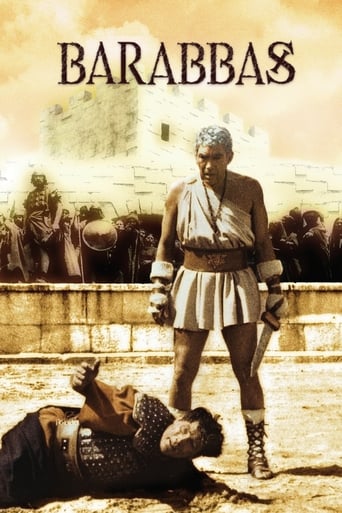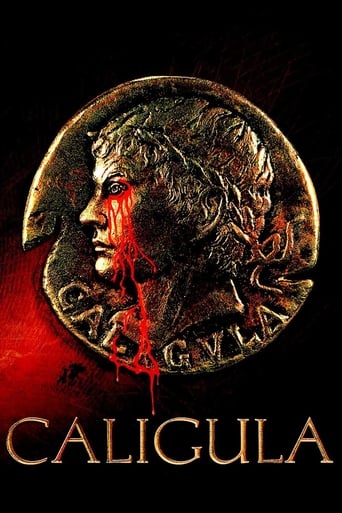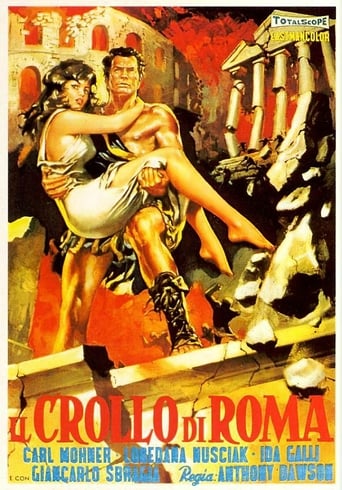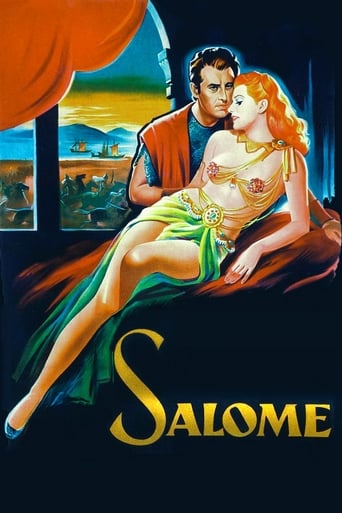
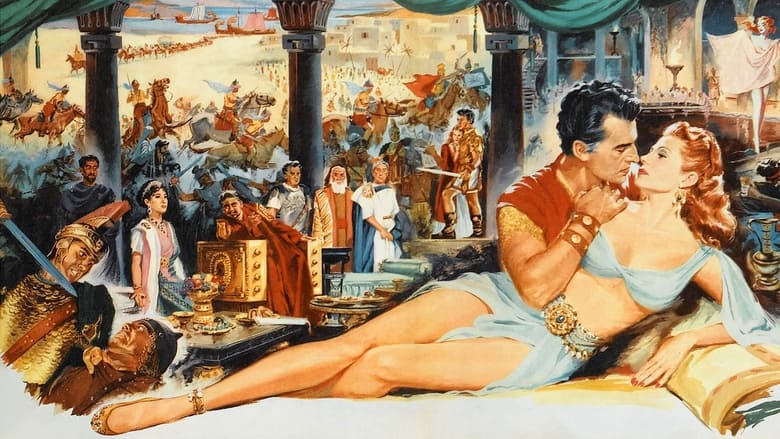
Salome (1953)
In the reign of emperor Tiberius, Gallilean prophet John the Baptist preaches against King Herod and Queen Herodias. The latter wants John dead, but Herod fears to harm him due to a prophecy. Enter beautiful Princess Salome, Herod's long-absent stepdaughter. Herodias sees the king's dawning lust for Salome as her means of bending the king to her will. But Salome and her lover Claudius are (contrary to Scripture) nearing conversion to the new religion. And the famous climactic dance turns out to have unexpected implications...
Watch Trailer
Cast
Similar titles



Reviews
hyped garbage
At first rather annoying in its heavy emphasis on reenactments, this movie ultimately proves fascinating, simply because the complicated, highly dramatic tale it tells still almost defies belief.
A terrific literary drama and character piece that shows how the process of creating art can be seen differently by those doing it and those looking at it from the outside.
Great story, amazing characters, superb action, enthralling cinematography. Yes, this is something I am glad I spent money on.
Epic films based upon the Bible were popular in the 1950s, but sometimes they were only very loosely so based. "Salome" is a case in point. The "damsel" whose seductive dance before King Herod led to the execution of John the Baptist is not actually named in the New Testament, but tradition has identified her with Princess Salome, the daughter of Queen Herodias and the niece and stepdaughter of Herod. She has traditionally been painted as the ultimate Bad Girl, a wanton teenage temptress whose thoughtless cruelty led to John's death. Well, in this film Salome is no longer a teenager but a mature beauty in her mid-thirties. (Rita Hayworth would have been 35 in 1953). More importantly, she is no longer a Bad Girl. (The studio, apparently, did not want Rita to play a villainess). To begin with, she is proud and independent-minded, but gradually softens under the influence of John's teaching and eventually converts to Christianity. (A "Salome" is numbered among Christ's followers in Mark's Gospel, but this is generally believed to have been a different person). Yes, she still gets to perform her sexy "Dance of the Seven Veils", but her motives for doing so are the precise opposite of those attributed to her in the Scriptures. In this version she is dancing in the hope that she can thereby influence the King to spare John's life. As the film opens, Salome is living in Rome, where she has lived for most of her life. She has fallen in love with Marcellus, nephew of the Emperor Tiberius, but he forbids their marriage, not wanting a member of his family to marry a "barbarian", and exiles her back to Galilee. Once there she finds herself in a complicated political situation, made more complex by the teachings of the Baptist who condemns Herod's rule and his adulterous marriage to his brother's wife. Herodias is furious, and demands that her husband condemn the Baptist to death for treason, but he is reluctant to do so, believing that he will be cursed if he does; his reluctance makes their already unhappy marriage even more strained. In the meantime, Salome has found a new boyfriend, the handsome Roman soldier Claudius, who shares her interest in John's teaching. Some later Biblical epics were an odd mixture of godliness and sexiness, combining an improving Christian moral with plenty of bare flesh on display. An example is "Esther and the King" in which Queen Vashti (who in the Bible is banished for refusing her husband's command to "show the people and the princes her beauty") gets into hot water for quite the opposite offence, that of showing them more of her beauty than she should by stripping down to her panties in the Royal Palace. In 1953, however, the Production Code was more rigidly enforced, so "Salome" is, on the surface at least, more godly than sexy. Hayworth's dance is really a Dance of the Six Veils, as she never removes the seventh and therefore remains fairly modestly clad to the end. Below that surface, however, there is a lot going on. Hayworth, as lovely in her thirties as she had been a decade earlier, was gifted enough, both as an actress and as a dancer, to convey a great deal of erotic allure even when fully clothed, and although the censors could come down hard on any explicit displays of nudity, this sort of subtle sexuality was much more difficult for them to control. "Salome" is far from being Rita's greatest film (that was probably "Gilda"), but that dance is one of her greatest moments. (She later claimed it was "the most demanding of her entire career" as the director William Dieterle demanded endless retakes). Among the other actors, the best contribution comes from Charles Laughton as the slimily lecherous Herod. Laughton had a tendency to overact, but in a role like this overacting is not necessarily a bad thing. Easily the worst comes from Alan Badel, playing John the Baptist not so much as a prophet as a swivel-eyed religious maniac, the first- century Galilean equivalent of a Hyde Park soapbox preacher. Judith Anderson is good as Herodias, but Stewart Granger is a bit wooden as Claudius, possibly because his character does not have much to do except stand around to provide a love-interest for the leading lady. "Salome" will never, in my opinion at least, rank alongside the grand epics like "Ben-Hur" or "Spartacus"; there is too much of the smell of cheesy Hollywood sanctimoniousness about it. It does, however, have its virtues, and is certainly better than the likes of "Esther and the King", "The Silver Chalice" or "Sodom and Gomorrah", all of which do not just smell of sanctimoniousness but positively reek of it. It makes enjoyable, if undemanding, watching on a Sunday afternoon. 6/10 Some goofs. Claudius and Pontius Pilate refer to their military service in Britain, but Britain was not a Roman province during the reign of Tiberius. And whatever persuaded the scriptwriter that Gila monsters (natives of Mexico and the American South-West) are to be found in Israel?
Quite a complicated and interesting drama, based on the well known, but previously much altered and embellished brief biblical story of Salome(unnamed in the bible): daughter of Herodias and stepdaughter of Herod Antipas: ruler of Galilee, and the involvement of these 3 in the dramatic serving of John the Baptist's head at a lavish birthday banquet hosted by Herod.In this version, we have two scorned women in Salome(Rita Hayworth) and Herodias(Judith Anderson). These events occur early in the film. First, there is a report that the Jewish prophet John the Baptist has returned from the wilderness. He has been criticizing the (clearly loveless) marriage of Herodias and Herod as defying Jewish law, Herodias being the former wife of Herod's brother, who is Salome's biological father. Herodias petitions Herod(Charles Laughton) to have this busybody crank put to death. But Herod fears he may be the rumored messiah, and that his death by his edict might cause bad things to happen and the common people to riot against him. Fortunately, for Herod, John has also been preaching things treasonous to Rome. Thus, he has other pretexts to jail, if not execute, him. This doesn't happen until late in the story. Meanwhile, in a completely novel embellishment of the story, we find Salome having lived in Rome most of her life, as a spoiled princess. Now, Marcellus, cousin of the emperor asks permission to marry her. The emperor refuses, because Salome is not of royal Roman blood. Furthermore, he banishes her back to Galilee, charged with being a barbarian and woman of ill-repute. After failing to convince Marcellus to renounce his Roman citizenship, she boards a ship also carrying the newly appointed governor of neighboring Judea: an unimpressive Pontius Pilot(P.P.). Also prominent is P.P.'s new commander of the occupying army: impressive Claudius(Stewart Granger), who has 5 years diplomatic experience in Galilee, and is a friend of John the Baptist(however unlikely!), as well as a previous comrade in battle with P.P. They talk about their old times fighting the Britains(which historically didn't happen until several decades later!). P.P. tells Claudius to get Salome out of his quarters on the ship. But Claudius is cowed by her tongue lashing about all Romans, whom she doesn't want to see or speak to for the rest of the journey. But, later he surprisingly steals a kiss when she asks for water for a bath, and continues to confidently tease her arrogance during their overland journey to Galilee.During this journey, John and followers are encountered. Alan Badel, as John, is presented as an upward-gazing mystic, looking like a popular painting of Christ, with piercing blue eyes, in marked contrast to the clean-shaven Romans. But John refuses to heed Claudius's advice not to preach in the cities, nor bad mouth the Romans. Hence, John is later arrested. His riveting exchanges with Herod and his council is one of the highlights of the film. He disclaims being the Messiah, but says he is loyal to an unseen God mightier than any earthly king. Herod has prearranged with Salome to jail John, rather than put him to death, as his ministers, Herodias, and P.P. wish.Meanwhile, Claudius has gone to see P.P. to try to convince him to support, rather than persecute, what Claudius sees as an emerging new religion that will bring peace and prosperity to the Roman world. Suggests P.P. may become famous(rather than infamous) by doing so. But, P.P. disagrees, ordering Claudius to stay out of Galilee until he can be deported back to Rome. P.P. happens to mention a carpenter in his realm, who is claimed to perform miracles. Claudius goes looking for him and witnesses some of his miracles. Disobeying P.P., he returns to visit John and Salome in John's cell, to tell them about Jesus, whom John claims is the messiah.Claudius and Salome then scheme to release John. Claudius is head of the palace guard, so tells them to release John. But Salome says she will dance at Herod's banquet that evening, and ask for John's release. Salome does the 'dance of the 7 veils'. But, strangely, Herod does what Herodias, not Salome, asks! Apparently, Herod agreed to her request for John's head, with the understanding that she then agreed to his attempted seduction of Salome! After wrestling John away from Claudius, Herod's soldiers behead John and deliver it on a platter. I can still hear Rita scream! The film ends with Claudius and Rita attending Christ's Sermon on the Mount. Thus, they symbolize the beginning of the eventual conversion of most of the Roman world to this new religion.I thought Stewart Granger did an excellent job in his unlikely role as the first important Roman to embrace this new religion, dragging Salome along. This theme would be revisited, more dramatically, the following year, in "The Robe". Laughton also did an excellent job as the severely conflicted Herod, as intent on seducing Salome as in preserving the life of John, with ultimate failure on both counts. Rita is also interesting as an unconventional over-aged seductive version of the traditionally teen Salome, with a mind of her own and care about her virtue. Judith's Herodias is to be pitied as the virtually discarded wife of Herod, transferring much of her anger to John.
Salome certainly isn't a terrible film, far from it. But I do think, as a biblical epic it is flawed in many ways. The costumes and the scenery were a joy to the eyes, and the music was beautiful and a treat to the ears. The acting is pretty good too, with Stewart Granger handsome in his role, and Judith Anderson deliciously cruel as Herodias, though Anderson to be fair has given better performances in classics like And Then There Were None and Rebecca. Charles Laughton gives one of his career's weakest performances, but he is good as King Herod to some extent. The film's portrayal of John the Baptist from Alan Badel was also fine, but Salome's creme de la creme is Rita Hayworth in the title role. Entirely captivating and so beautiful, and she danced beautifully in Dance of the Seven Veils which also happens to be a scene from Richard Strauss's opera of the same name. However, the film's flaws include pedestrian pacing, an underdeveloped script and a story that suffers from a lot of tampering. Overall, deeply flawed, but watchable biblical film, that is worth watching if only for Hayworth and Dance of the Seven Veils. 6/10 Bethany Cox
At thirty-five, RITA HAYWORTH was obviously not the right age to play the youthful Salome, but Columbia knew that audiences would forgive them by making sure that it was well advertised she would do "The Dance of the Seven Veils" long before the film premiered. Taken strictly as a Rita Hayworth vehicle, it manages to be one of her better assignments after returning to films from a broken marriage as a princess.She's still an eyefull in her Salome costumes but the main problem with SALOME is the ludicrous script which has her dancing the famous number in order to save John the Baptist--so that the evil one will be seen as JUDITH ANDERSON (Queen Herodias). Miss Anderson does make a fine villainess and she and CHARLES LAUGHTON at times seem to be overcoming the inadequacies of a dull script. STEWART GRANGER has one of his less rewarding leading man roles but, as usual, looks striking in his period costumes and photographs well with Hayworth.As for her dance--well, it's probably the high point of an otherwise bland film and she does quite a job of undulating gyrations under the lecherous eye of CHARLES LAUGHTON as King Herod. Rita still had all of her dancing abilities well under control and does a nice job of--here at least--trying to spare John the Baptist (ALAN BADEL).It's gaudy and Technicolored and Rita's fans at least got to see her do some exotic work--but the film itself is about as banal as any Biblical drama of the '50s (with the exception of BEN-HUR) with no regard for historical accuracy.

